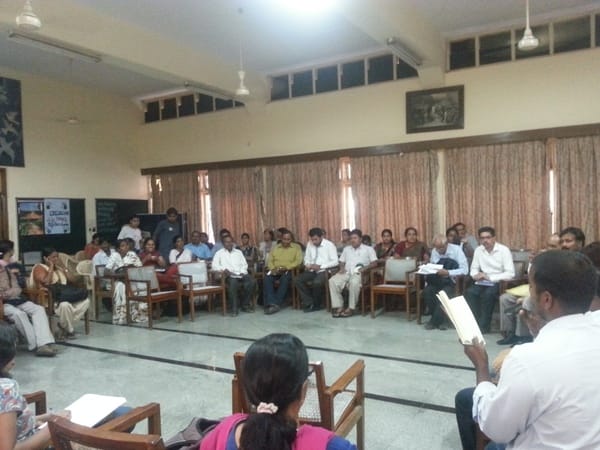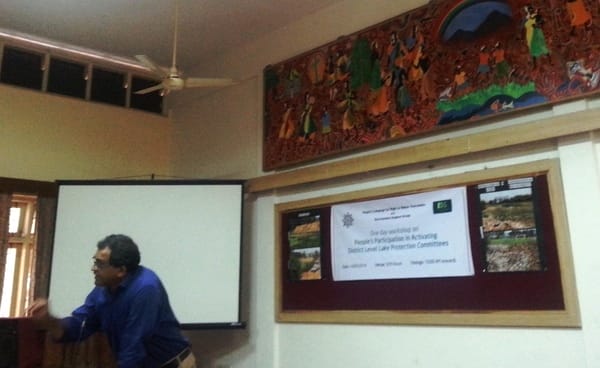Alright. We all know lakes are vanishing fast in Bengaluru. Many groups are fighting to save some lakes. However the mission hits the dead end when complaints to stop the encroachment yield no results. We also have heard about a District Lake Committee which is supposed to protect lakes. However, we don’t see this committee active. So what’s wrong?
What is this committee supposed to do?
In December 2013, the Karnataka High Court passed a revolutionary judgment in response to a PIL filed by Environment Support Group (ESG), directing the State Government to set up Lake Protection Committees to oversee the protection and rehabilitation of lakes and rajakaluves. In addition to mobilising the government to take action, these committees would also act as a platform for local people to participate in protecting the lakes.
Following the judgement, the court directed that the committees undertake the following to have an integrated and coordinated maintenance and management of lakes.
-
Survey of lakes and tanks in Karnataka to be undertaken by demarcating the boundaries and making proper boundaries
-
Unauthorised construction within 30 meters of peripheral lake area to be removed
-
Removal of silt, as well as scientific de-weeding for the rejuvenation of some of the tanks and creating proper embankments to be done periodically
-
Flow of sewage water into lakes and tanks has to be stopped. The channels, which feed the lakes have to be properly protected and maintained
-
The forest department to undertake the planting of trees and saplings in the buffer area of the lake
-
The Commissioner of BBMP is responsible for the proper maintenance and development of lakes within the BBMP area.
-
The Commissioner of BDA, the Chief Executive Officer and the Lake Development Authority and the deputy Conservator of the Forest shall be the committee for proper maintenance and development of lakes in the Bangalore Metropolitan Area.
-
The Deputy Commissioner of the district, the commissioner of the city municipal corporation and the commissioner of the Urban Development Authority shall be the committee for proper maintenance and development of lakes in the city municipal corporation area.
-
The Deputy Commissioner of the district, commissioner of municipality and district water resource officer shall be the committee for the proper maintenance and development of lakes in the municipal and taluk offices.
-
An Apex Committee consisting of Principal Secretary from Department of Revenue, CEO, Lake Development Authority and Member Secretary of State Legal Services authority will oversee and the supervise the maintenance of lakes by the above stated committees. The committees will send a quarterly report about the maintenance and development of lakes to the Apex Committee. The Apex Committee can also entertain complaints and give proper directions to concerned committees for proper maintenance and development of the lakes.
The State government has so far failed to operationalise the District Lake Protection Committees. In spite of the High Court mandate, a contempt notice to the Chief Secretary and the subsequent setting up of the committees, there is no sign that they are functional as yet. And while the city waits for the ball to start rolling, encroachment and destruction of the lakes continues unabated.
So how can Bangalore protect her lakes?
Bangalore is so much more than just a place. Bangalore is her people — it is her people that will finally need to come to her aid. Two citizen groups Environment Support Group (ESG) and People’s Campaign for Right to Water-Karnataka joined hands to conduct a workshop that would help people activate the lake protection committees.
The workshop aimed to educate people about the situation of lakes across Karnataka and the importance of protecting them. People from Tumkur, Kollegal and Mysore attended the workshop, while people from Bangalore were more. During the course of the workshop, attendees were educated about the High Court order as well as other progressive judgments on protecting lakes and saving social commons. In addition, participants shared their experiences and efforts in protecting the lakes.

Participants share their experiences and efforts in protecting lakes. Pic: Ganga Madappa
Leo Saldanha, coordinator at ESG, and a long time lake activist, referring to the 40 odd lakes that have gone off the record since 1976, stated, “When lakes start disappearing, it is a sign that we do not have any control over our commons.” He added that the BBMP or whomsoever the government appointed to look after the lake was merely a custodian of it, it did not belong to them. If the custodians of the public commons do not do their due diligence, it was up to the common man to step in.
What is the way forward to protect lakes?
The following action plan was put together to pave the way forward for the protection of lakes.
-
Formation of District people’s lake protection networks which meets once in a month to review the situation of the lakes and the actions taken by the District Level lake protection committees. Bangalore District’s People’s Lake Protection Network specifically for Bangalore.
-
People’s mandate for the state government to survey all the lakes in Karnataka within next three months and to make the survey details public. The lakes should be surveyed as per the guidelines mentioned Justice N K Patil report .
-
To analyse the quality of water in each lake and to publish the report every quarter
-
District Level Lake protection committees should announce one Saturday of every month as public meeting day.
-
Ward committees and Gram Panchayats should be activated to democratise the governance of local water sources like lakes, ponds, streams, catchment areas and to ensure their patency by preventing encroachments, pollution etc.
-
All wards to develop a plan within next three months to green the lake boundaries and rajakaluves (storm water drains)
-
Lakes that are polluted and or encroached to be surveyed and the survey report should be made public.
-
Awareness programmes on protecting the lakes at Zonal Levels and simultaneously working on activation the District Lake Protection Committees across all districts in Karnataka.
-
Pooling data on water availability, water usage, studying changes in irrigation methods, changes in cropping pattern, drawing the links to migration and urbanisation. Coming up with ideas on water planning and water budgeting.
-
Sensitisation programmes for Encroachers, Ward Committees members
-
Studying history and come up with plan to rejuvenate lakes and tanks. Read more on Tank panchayats that were present in the past.
-
Forming vigilante groups of citizens in lake vicinities.
-
Every district in the state should be provided with one help line number (same number for all the districts) where people can lodge their complaints about lakes.
What can you do to protect lakes?
The first step would be to get your hands on the history of the lake. Topography sheets can be found at the Survey of India office in Koramangala. Obtain old village maps and revenue maps from the tahsildar’s office in your neighbourhood. You can also track the changes to the topography of the land on Google Earth – this will give you an inkling of how much of the lake has been encroached, across several decades. Ensure you put up all the documents in the public domain.

Somasundarapalya Lake timeline (From left to right – 2000, 2011, 2014). Pic: Balasubramanian Thirunavukkarasu from Google Earth
If the Lake Protection Committee in your area is yet to begin work, you can file a complaint. The committee needs to respond to your complaint in 30 days time. If there is no action taken by the Lake Protection Committee, approach the Apex Committee. Despite your efforts, if you still find no signs of progress, you can file a case with the High Court. If the committee does not function as per the High Court mandate, it is considered contempt of court.
You can also get in touch with the folks at ESG and People’s Campaign for Right to Water-Karnataka for guidance on where you can begin.

Saldanha lists out the steps to file a complaint in case of inaction. Pic: Ganga Madappa
Do have a look at the Guidelines and Models for Ecological Restoration of Lakes as suggested by the Justice Patil report to get an idea of the process involved. Another useful resource is Arathi’s article on Citizen Matters – How to revive your neighbourhood lake.
Ward committees or trusts – what is the way forward?
It is essential that the local neighbourhood is involved in the process of rejuvenating the lakes. For this, the ward committees must be sensitised about the need to protect our lakes. There are several lakes such as Puttenahalli Lake and Kaikondrahalli Lake which have benefited from the active citizenship of folks staying in and around the vicinity of the lake. In these specific cases, trusts were set up and citizens have taken on the responsibility of managing and planning for the lakes into their own hands.
Saldanha did raise concerns about lakes being managed by trusts, stating that this could imply that the lake ceases to be a part of the commons as a result of it being managed by a set of people, usually from the affluent class. He cited the example of a public park, where the trust set up by the RWA, from managing the park, turned to claiming ownership of the park.
Bhargavi Rao from ESG stated that setting up trusts to manage lakes was akin to undermining democracy and the idea of the social commons. Arathi Manay Yajaman, a trustee of Puttenahalli Lake Improvement Trust (PNLIT) stepped up to clarify the trust’s role with relation to the lake and stated that but for their intervention, the lake could have been destroyed by now. She too did acknowledge that lakes are commons.
Take the first step!
Fighting for the restoration of a lake is not something that can be done in a short span of time, one needs to be in it for the long haul. As Saldanha put it, “If you are looking for visible change in six months, you’re already running late. If you start today, the changes will be visible in three years from now”.
While protecting lakes is only a partial solution to the inevitable water crisis that the city will face if things carry on in the manner that they are today, it is certainly a step in the right direction.
Related Articles
Bannerghatta Road residents team up to try save lake
How to revive your neighbourhood lake
Bannerghatta Road residents team up to try save lake
How to revive your neighbourhood lake
Group asks govt to operationalise District Lake Protection Committees